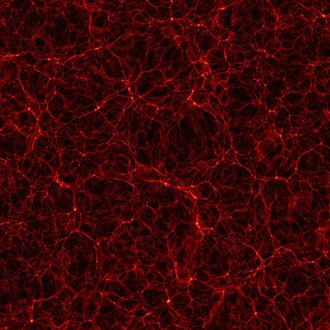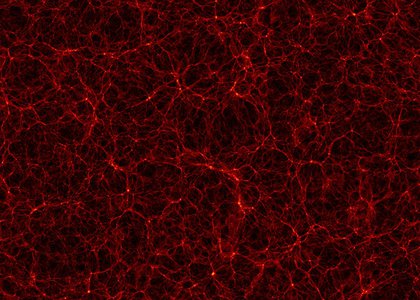Dwarfs of the Milky Way

The Cosmic Web. When examined on the largest possible scales, matter in the universe segments into a filamentary network of bridges as shown here in this computer simulation. The brighter tendrils in the image represent regions where the density of matter is high and where galaxies are expected to reside. It is along these dark matter cosmic superhighways along which satellite galaxies are thought to travel.
Credit: S. Gottloeber and tthe MultiDark collaborationNoam Libeskind, scientist of the Leibniz Institute for Astrophysics Potsdam (AIP), explains in an article in the latest issue of “Scientific American”, why dwarf galaxies (also called “satellite galaxies”) are arranged on a plane instead of being scattered randomly. Superhighways of Dark Matter might be the solution to this astronomic puzzle.
Noam Libeskind: “Most galaxies like the Milky Way are surrounded by dozens of small “satellite galaxies” that orbit around them. In the case of our Milky Way these satellite galaxies don’t just fly around haphazardly - instead the satellites are all arranged on a plane. Surprisingly, this situation has just been discovered in our closest neighbor Andromeda, as well. What’s more, at least in the Milky Way’s case, this plane is roughly perpendicular to the disc of our Galaxy.”
“The problem is simple:” he continues, “if the universe is dominated by dark matter (which we believe it is), satellites should be randomly distributed about the Milky Way, not sitting on a thin plane. The origin of this alignment has thus puzzled astronomers for at least four decades, and computational cosmologists have been attempting to model the dynamics for many years. In fact, many cosmologists think that the distribution of the satellites encodes information about the mechanics of the very formation and origin of the Milky Way. Recent work, including my own research, proposes a compelling solution to this problem: the satellite galaxies did not flock to the Milky Way from all directions, but were shot towards it along cosmic superhighways of Dark Matter, thus giving the satellites a preferred direction and alignment.”
The article “How The Milky Way Got Its Dwarf Galaxies” was published in the March issue of Scientific American.
Science contact: Dr. Noam I. Libeskind, nlibeskind@aip.de, +49 331-74 99-641

The Cosmic Web. When examined on the largest possible scales, matter in the universe segments into a filamentary network of bridges as shown here in this computer simulation. The brighter tendrils in the image represent regions where the density of matter is high and where galaxies are expected to reside. It is along these dark matter cosmic superhighways along which satellite galaxies are thought to travel.
Credit: S. Gottloeber and tthe MultiDark collaborationNoam Libeskind, scientist of the Leibniz Institute for Astrophysics Potsdam (AIP), explains in an article in the latest issue of “Scientific American”, why dwarf galaxies (also called “satellite galaxies”) are arranged on a plane instead of being scattered randomly. Superhighways of Dark Matter might be the solution to this astronomic puzzle.
Noam Libeskind: “Most galaxies like the Milky Way are surrounded by dozens of small “satellite galaxies” that orbit around them. In the case of our Milky Way these satellite galaxies don’t just fly around haphazardly - instead the satellites are all arranged on a plane. Surprisingly, this situation has just been discovered in our closest neighbor Andromeda, as well. What’s more, at least in the Milky Way’s case, this plane is roughly perpendicular to the disc of our Galaxy.”
“The problem is simple:” he continues, “if the universe is dominated by dark matter (which we believe it is), satellites should be randomly distributed about the Milky Way, not sitting on a thin plane. The origin of this alignment has thus puzzled astronomers for at least four decades, and computational cosmologists have been attempting to model the dynamics for many years. In fact, many cosmologists think that the distribution of the satellites encodes information about the mechanics of the very formation and origin of the Milky Way. Recent work, including my own research, proposes a compelling solution to this problem: the satellite galaxies did not flock to the Milky Way from all directions, but were shot towards it along cosmic superhighways of Dark Matter, thus giving the satellites a preferred direction and alignment.”
The article “How The Milky Way Got Its Dwarf Galaxies” was published in the March issue of Scientific American.
Science contact: Dr. Noam I. Libeskind, nlibeskind@aip.de, +49 331-74 99-641
Images
The Cosmic Web. When examined on the largest possible scales, matter in the universe segments into a filamentary network of bridges as shown here in this computer simulation. The brighter tendrils in the image represent regions where the density of matter is high and where galaxies are expected to reside. It is along these dark matter cosmic superhighways along which satellite galaxies are thought to travel.



